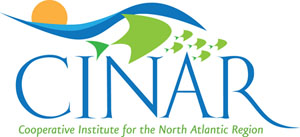Commentary
Fundy North Fishermen Clean up the Seafloor
Earlier this year, the Fundy North Fishermen’s Association was the recipient of the first Gulf of Maine Council on the Marine Environment (GOMC) Industry Award for work retrieving derelict lobster fishing gear from the seafloor in Saint John Harbour, New Brunswick.
Saint John, known as the “Port City.” has a very active and growing shipping industry co-existing with a centuries-old lobster fishery. Tensions can run high between the two industries when ship traffic cuts off lobster gear or fishermen plug up traffic lanes. The gear fishermen lose each season can remain on the seafloor for decades, continuing to trap lobster, and having a negative influence on lobster numbers and the livelihoods that depend on the lobster population.
Brothers John and Greg McDade grappling for traps.
A few years ago, three Saint John Harbour fishermen — Roger Hunter, John McDade and David Thompson — got a bright idea, to develop a technique to retrieve lost gear. One member of the shipping industry, Canaport LNG, put up the funding for the pilot project through the Department of Fisheries and Oceans’ (DFO) Harmful Alteration Disruption and Destruction (HADD) program. Under this program, Canaport LNG was required to conduct a habitat restoration project to offset the environmental impact of building their LNG pier. The fishermen were happy to bring forward their idea for ghost trap retrieval.
In the summers of 2008 and 2009, the Fundy North Fishermen retrieved over 500 derelict lobster traps from the seafloor. It was not an easy task, they said, requiring the skills of seasoned fishermen and lots of trial and error.
The fishermen designed and built three different grapnel prototypes to snag the traps. With the help of Fundy Engineering, these grapnels were tried and modified until they could perform the job at hand. The biggest problem the fishermen had with the grapnels was that they grabbed too well. I watched the fishermen load the first grapnel prototype onto a fishing boat and it snagged everything in sight including one fishermen’s shirt! The first two grapnels were lost at sea early on in the project. One of these was retrieved at low tide with a backhoe (it was snagged on a large piece of metal construction debris), and the other remains lost to this day. In spite of these early problems, by the end of the first summer the fishermen had become quite adept at retrieving gear.
Brothers John and Greg McDade grappling for traps.
Key to the success of the project was a high resolution side scan sonar survey of the harbour seafloor. The survey yielded a map with thousands of potential targets (lost traps). Not all of these targets turned out to be lobster traps: the fishermen pulled up numerous logs, steel cables, chunks of metal and even a huge antique iron anchor. With all the debris on the bottom of Saint John Harbour, trap retrieval was a difficult and dangerous task. Traps often came up entangled in other debris making for a very heavy load. Fishermen had to have their wits about them to keep safe as they hauled in the gear.
An important aspect to this project was examining how well the “ghost panels” on today’s lobster traps function. Fishermen are required by law to install escape panels on the ends of their traps. These panels are attached to the trap with degradable metal rings that rust out in time and allow the trap to open, letting the lobsters free.
We wanted to know how long it took for these panels to open and if lobsters could indeed get free. On average, it took less than one year on the seafloor for the panels to open, but not all the lobsters could move freely out of the trap. We discovered that very large lobsters could enter the trap but were not able to fit through the escape panel. As a result, Fundy North Fishermen are proposing that all fishermen install a larger diameter ghost panel to allow the largest lobsters to escape.
Fishermen working on this project also found evidence of illegal ghost panels. Some of these were too small and some were attached with stainless steel rings that will never degrade and rust out. As a result, Fundy North has mounted a campaign aiming at 100 percent compliance with the ghost panel rules. A special newsletter was distributed to all 178 lobster license holders in the district, which included photos of traps full of dead and decaying lobsters to stress the importance of the ghost panel regulations. As a result, we are seeing much higher compliance rates.
There are no concrete plans to continue gear retrieval in the future, though both the fishermen and the shipping industry are interested in a future partnership. Since no retrieval program can be 100 percent effective, the best solution is to eliminate or at least significantly reduce the incidences of gear loss in the first place.
Brothers John and Greg McDade grappling for traps.
In a high traffic port like Saint John Harbour this is a difficult task. Nonetheless, Fundy North Fishermen’s Association meets regularly with the shipping industry to try to find a solution to the gear loss problem. Many fishermen have changed their fishing strategy to reduce gear loss using trap trawls, cooperating on how they set their traps, and marking shipping lanes with high fliers so everyone knows where they are. In addition, the two industries are doing a much better job of communicating with each other both on the water and in the boardroom.
The Fundy North Fishermen’s Association represents inshore fishermen from St. Martin’s to Campobello Island, New Brunswick, Canada. Our members harvest lobster, scallops, groundfish, shrimp, gaspereau, shad and eel. There are up to 75 lobster boats that fish in Saint John Harbour during the spring season, making it one of the most lucrative, and crowded, fishing grounds on our coast.
Maria Recchia
Executive Director
Fundy North Fishermen’s Association






















